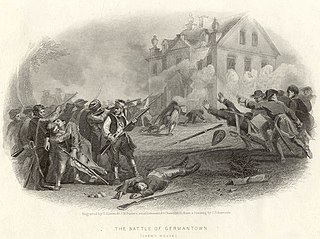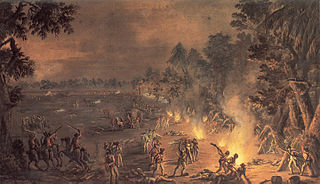
The Battle of Germantown was a major engagement in the Philadelphia campaign of the American Revolutionary War. It was fought on October 4, 1777, at Germantown, Pennsylvania, between the British Army led by Sir William Howe, and the American Continental Army under George Washington.

The Battle of Paoli, also known as the Battle of Paoli Tavern or the Paoli Massacre, was a battle in the Philadelphia campaign of the American Revolutionary War fought on September 20, 1777, in the area surrounding present-day Malvern, Pennsylvania. Following the Continental Army's retreat in the Battle of Brandywine and the aborted Battle of the Clouds, George Washington left a force behind under the command of Brigadier General Anthony Wayne to monitor and resist the British as they prepared to attack and occupy the revolutionary capital of Philadelphia.
The 2nd New Jersey Regiment was raised, on 9 October 1775, at Trenton, New Jersey, for service with the Continental Army under the command of Colonel William Maxwell. The regiment would see action at the Battle of Trois-Rivières, Battle of Valcour Island, Battle of Brandywine, Battle of Germantown, Battle of Crooked Billet, Battle of Monmouth, Sullivan Expedition, Battle of Springfield and the Battle of Yorktown. The regiment was furloughed, on 6 June 1783, at Newburgh, New York, and disbanded 3 November 1783.
The 1st Pennsylvania Regiment - originally mustered as the 1st Pennsylvania Rifles; also known as the 1st Continental Line and 1st Continental Regiment, was raised under the command of Colonel William Thompson for service in the Continental Army.
The 2nd Pennsylvania Regiment, formed with lauded veterans from the 1st Pennsylvania Battalion, was raised in December 1776. The 1st Pennsylvania Battalion was raised in October 1775, under the command of Colonel John Bull for service with the Continental Army.
The 3rd Pennsylvania Regiment, first known as the 2nd Pennsylvania Battalion, was raised on December 9, 1775, at Philadelphia, Pennsylvania for service with the Continental Army. The regiment would see action during the Battle of Valcour Island, Battle of Brandywine, Battle of Germantown, Battle of Monmouth and the Battle of Springfield. The regiment was furloughed, on June 11, 1783, in Philadelphia, and disbanded on November 15, 1783.
The 4th Pennsylvania Regiment, first known as the 3rd Pennsylvania Battalion, was raised on December 9, 1775, at Philadelphia, Pennsylvania, for service with the Continental Army. The regiment was assigned to Thomas Mifflin's brigade in the main army on June 26, 1776. Part of the unit was captured at Fort Washington on November 16, 1776. The regiment fought at Brandywine, Paoli, Germantown, Monmouth and the Sullivan Expedition. The regiment was furloughed on January 17, 1781, at Trenton, New Jersey and disbanded on January 1, 1783.
The 6th Pennsylvania Regiment, first known as the 5th Pennsylvania Battalion, was a unit of the United States of America (U.S.) Army, raised December 9, 1775, at Philadelphia, Pennsylvania, for service with the Continental Army. The regiment would see action during the New York Campaign, Battle of Brandywine, Battle of Germantown, Battle of Monmouth, and Green Spring. The regiment was disbanded on January 1, 1783.

The 7th Pennsylvania Regiment was an infantry unit raised on 4 January 1776 at Carlisle, Pennsylvania for service with the Continental Army under Brigadier General Anthony Wayne during the American Revolutionary War. The well known iron work owner and cannon supplier Samuel Van Leer was a captain in this regiment. On 17 January 1777 Lieutenant Colonel Thomas Hartley transferred out of the unit to take command of Hartley's Additional Continental Regiment. The 7th Regiment saw action at the battles of Brandywine, Paoli, Germantown, Monmouth, Springfield and Bull's Ferry. At Monmouth, Colonel William Irvine led the regiment. The unit merged with the 4th Pennsylvania Regiment on 17 January 1781.
The 8th Pennsylvania Regiment or Mackay's Battalion was an American infantry unit that became part of the Continental Army during the American Revolutionary War. Authorized for frontier defense in July 1776, the eight-company unit was originally called Mackay's Battalion after its commander, Colonel Aeneas Mackay. Transferred to the main army in November 1776, the unit was renamed the 8th Pennsylvania Regiment on 1 January 1777. It completed an epic winter march from western Pennsylvania to New Jersey, though Mackay and his second-in-command both died soon afterward. In March 1777 Colonel Daniel Brodhead assumed command. The regiment was engaged at the Battles of Bound Brook, Brandywine, Paoli, and Germantown in 1777. A body of riflemen were detached from the regiment and fought at Saratoga. Assigned to the Western Department in May 1778, the 8th Pennsylvania gained a ninth company before seeing action near Fort Laurens and in the Sullivan Expedition in 1778 and 1779. The regiment consolidated with the 2nd Pennsylvania Regiment in January 1781 and ceased to exist.
The 9th Pennsylvania Regiment was authorized 16 September 1776 and was assigned to the main Continental Army on 27 December 1776. It was organized during the spring of 1777 to consist of eight companies of volunteers from Westmoreland, Lancaster, Chester, Philadelphia and Cumberland counties of the commonwealth of Pennsylvania. The regiment was assigned to the 3d Pennsylvania Brigade of the main Continental Army on 27 May 1777. On 1 July 1778 the regiment was re-organized into nine companies. On 22 July 1778 the regiment was reassigned to the 2d Pennsylvania Brigade. It was consolidated with the 5th Pennsylvania Regiment on 17 January 1781 and re-designated as the 5th Pennsylvania Regiment and concurrently furloughed at Trenton, New Jersey. The regiment would see action during the Battle of Brandywine, Battle of Germantown, Battle of Monmouth and the Battle of Springfield.
The 10th Pennsylvania Regiment was an American infantry unit that served in the Continental Army during the American Revolutionary War. Raised in September 1776 in the strength of eight companies, it was assigned to George Washington's main army in December 1776. Led by Colonel Joseph Penrose, the regiment fought under Thomas Mifflin at Princeton. In 1777 the unit was in action at Brandywine, Paoli, and Germantown during the time Adam Hubley was lieutenant colonel. At Monmouth in June 1778 Colonel George Nagel was in command. A few days after Monmouth, the regiment absorbed the 11th Pennsylvania Regiment and Colonel Richard Humpton took over the unit, which grew to nine companies in size. In 1780 the 10th fought at Springfield and Bull's Ferry. In January 1781 the 10th Pennsylvania merged with the 1st Pennsylvania Regiment and ceased to exist.
The 11th Pennsylvania Regiment or Old Eleventh was authorized on 16 September 1776 for service with the Continental Army. On 25 October, Richard Humpton was named colonel. In December 1776, the regiment was assigned to George Washington's main army and was present at Assunpink Creek and fought at Princeton in January 1777. During the spring, the unit assembled at Philadelphia, Pennsylvania in a strength of eight companies. The soldiers were recruited from Philadelphia and four nearby counties. On 22 May 1777, the regiment became part of the 2nd Pennsylvania Brigade. The 11th was in the thick of the action at Brandywine, Paoli, and Germantown in 1777. It was present at White Marsh and Monmouth. On 1 July 1778, the unit was consolidated with the 10th Pennsylvania Regiment, and the 11th Regiment ceased to exist. Humpton took command of the reorganized unit.
The 12th Pennsylvania Regiment also known as Northampton and Northumberland Defense Battalion was an American infantry unit that fought during the American Revolutionary War as part of the Continental Army. The regiment was raised 23 August 1776 at Sunbury, Pennsylvania, as a state militia regiment and later renamed the 12th Pennsylvania. In January 1777 the 12th was commanded by Colonel William Cooke at Princeton. Assigned to Thomas Conway's 3rd Pennsylvania Brigade, the regiment would see action at Brandywine, Germantown, and Monmouth. The regiment was merged into the 3rd Pennsylvania Regiment shortly after Monmouth and went out of existence.
The 3rd North Carolina Regiment was raised on 16 January 1776 at Wilmington, North Carolina for service with the Continental Army. In April, Jethro Sumner was appointed colonel. The regiment was present at the defense of Charleston in June 1776. The 3rd Regiment transferred from the Southern Department to George Washington's main army in February 1777. Assigned to Francis Nash's North Carolina Brigade in July 1777, it soon saw action at the battles of Brandywine and Germantown, and was present at White Marsh. Sumner went home ill in early 1778. Together with the 4th, 5th, and 6th North Carolina Regiments, the 3rd Regiment was reduced to a cadre and sent home to recruit up to strength on 1 June 1778. The rebuilt regiment returned to the main army in late 1778, but it was reduced to a cadre again in April 1779 and sent back to its home state. Assigned to the North Carolina Brigade, the regiment fought at the Siege of Charleston where it was captured by the British Army on 12 May 1780. The regiment was officially disbanded on 15 November 1783.
The 8th North Carolina Regiment was authorized on November 26, 1776, and assigned to the Southern Department of the Continental Army. The 8th North Carolina Regiment played a crucial role in the Defense of Philadelphia during the Philadelphia campaign. The unit saw action at the Battle of Brandywine, Battle of Germantown and the Battle of Monmouth during the Defense of Philadelphia of the American Revolution. A part of the continental army, the Regiment was commanded by Colonel James Armstrong. The regiment was disbanded on 1 June 1778 at Valley Forge, Pennsylvania.

Pennsylvania was the site of many key events associated with the American Revolution and American Revolutionary War. The city of Philadelphia, then capital of the Thirteen Colonies and the largest city in the colonies, was a gathering place for the Founding Fathers who discussed, debated, developed, and ultimately implemented many of the acts, including signing the Declaration of Independence, that inspired and launched the revolution and the quest for independence from the British Empire.
Hartley's Additional Continental Regiment was an American infantry unit of the Continental Army that served for two years during the American Revolutionary War. The regiment was authorized in January 1777 and Thomas Hartley was appointed its commander. The unit comprised eight companies from Pennsylvania, Maryland, and Delaware. When permanent brigades were formed in May 1777, the regiment was transferred to the 1st Pennsylvania Brigade. Hartley's Regiment fought at Brandywine, Paoli, and Germantown in 1777. The unit helped defend the Pennsylvania frontier against indigenous raids in the Summer and early Fall of 1778. In January 1779, following a resolution of the Continental Congress the regiment, along with Patton's Additional Continental Regiment and part of Malcolm's Additional Continental Regiment, were combined to form a complete battalion known as the "New" 11th Pennsylvania Regiment. The 11th participated in the Sullivan Expedition in the summer of that year. In January 1781 the 11th merged with the 3rd Pennsylvania Regiment and ceased to exist.
Spencer's Additional Continental Regiment, sometimes referred to as the 5th New Jersey Regiment, was an American infantry unit that served for four years in the Continental Army during the American Revolutionary War. The Continental Congress authorized sixteen "Additional" Continental Regiments in late 1776 and Colonel Oliver Spencer accepted command of this regiment with rank from January 15, 1777.



